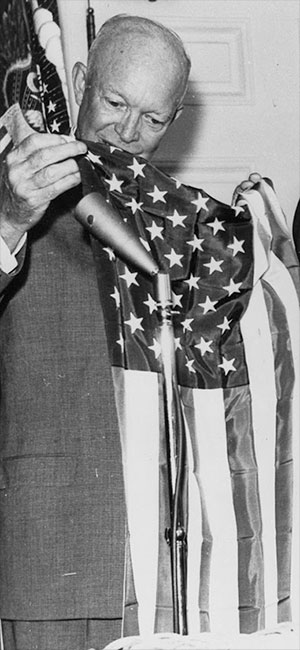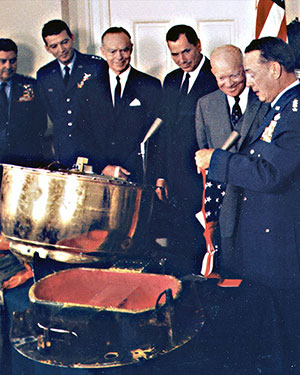August 20, 2020 — The first American flag to be flown into space and return to Earth intact did so 60 years ago this month — nine months earlier than another flag said to hold the same distinction.
Secretly stowed on board the first human-made object to be recovered from orbit, the U.S. flag was revealed during a White House ceremony on Aug. 15, 1960.
"Within this capsule, Mr. President, are a great many telemetering equipments and other scientific instruments, however there is one other package," Gen. Thomas White, Chief of Staff of the U.S. Air Force, said, addressing then-President Dwight Eisenhower before a small audience of military and government officials. "This is a national flag."
The 35.5-inch-wide by 24-inch-tall (90-by-61-centimeter) flag, which was carefully folded to fit into a small packet mounted to the inner wall of the Discoverer XIII (13) reentry capsule, was presented by White to Eisenhower, making it also the first example of space memorabilia from orbit.
"Quite naturally, I am proud that someone thought of the thoughtful gesture, so far as I was personally concerned, of giving me this little flag that has certainly now for itself a unique history," Eisenhower said, holding up the unfolded flag. "I will try to see that it is put into a place where all Americans can see it and be reminded of this great accomplishment."
It is not clear if the flag went on display before Eisenhower had it transferred to the National Archives in late 1960, but the flag was at least briefly forgotten to history, as it led to another Stars and Stripes banner being identified as the first to fly into space after it launched with first U.S. astronaut in May 1961.
More than one launch
Today, Eisenhower's space-flown flag is held in the archives of his Presidential Library, Museum and Boyhood Home in Abilene, Kansas. It was last seen by the public in 2011 as part of a prior exhibit at the museum.
Though the flag was the first to be retrieved from orbit, it was not the first to fly, according to anecdotal reports by team members.
The Discoverer program was the public cover for the CIA and U.S. Air Force's classified series of Corona reconnaissance satellites. The Discoverer XIII reentry capsule that returned the flag to Earth was developed to return film reels from space, which began with the next launch.
There was no way for those working in Lockheed's "Skunk Works" advanced development division to know which flight would be the first to succeed, so flags were prepared and flown on several of the capsules that were launched and lost before Discoverer XIII was recovered from the Pacific Ocean.
As it happened, the Discoverer XIII mission was the first to occur after the July 4, 1960 first official raising of the 50-star American flag at Fort McHenry National Monument in Baltimore, Maryland, in recognition of Hawaii becoming the 50th state of the United States of America. Thirty-seven days later, Discoverer XIII lifted off atop a Thor-Agena rocket from Vandenberg Air Force Base in California with not just the first U.S. flag to orbit Earth and return safely, but one of the first 50-star flags to represent the country as part of a national event.
"This flag contains 50 stars," White told Eisenhower. "It is perhaps significant that this flag was released from orbit in outer space in the vicinity of our 49th state and recovered in the vicinity of the 50th state, Hawaii."
'Souvenir-launching'
The public presentation of the Discoverer XIII flag gave rise to an official — and unofficial — tradition of flying memorabilia on U.S. space missions.
On a subsequent Discoverer (Corona) flight, a post-recovery inspection found two quarters and a buffalo nickel inside the capsule, apparent unauthorized mementos that were placed aboard by launch team members.
"The Washington program office sent a sharply worded message to the West Coast project office charging it with responsibility for ensuring that the practice of souvenir-launching be stopped," the history staff at the CIA Center for the Study of Intelligence wrote in a 1995 history of the Corona program.
The custom, though, found a new home at NASA with the first flights of Americans into space.
Unbeknownst to him at the time, astronaut Alan Shepard lifted off with a U.S. flag aboard Freedom 7, his Mercury capsule for the nation's first piloted mission. The 23-by-36-inch cloth (58-by-91 cm) flag, which had been rolled up and stuck within a wiring bundle in the spacecraft, was revealed after Shepard's splashdown. The flag was later donated to the Smithsonian.
"This flag, which accompanied NASA astronaut Alan B. Shepard on his 15-minute suborbital journey on May 5, 1961 as the first U.S. human spaceflight, was apparently the first U.S. flag flown into space," the Smithsonian's National Air and Space Museum describes as part of its online collection catalog.
It was not the first, but the Mercury-Redstone 3 flag holds another distinction: it flew again. In 1995, still on loan from the Smithsonian, it was packaged up and launched aboard space shuttle Atlantis on the 100th human spaceflight flown by the United States. Today, it is on display outside the entrance to the Astronaut Hall of Fame at NASA's Kennedy Space Center Visitor Complex in Florida.
The preceding article serves as a correction to collectSPACE's July 4, 2010 story, "Stars, stripes and space: NASA and the 50 star American flag," in which it was erroneously stated that the flag flown with Alan Shepard was "the first American flag to have ever left the planet." |
|

President Dwight D. Eisenhower examines the first American flag flown and returned from Earth orbit on the Discoverer XIII reentry capsule during an Aug. 15, 1960 ceremony at the White House in Washington, D.C. (General Electric Company/miSci)

Gen. Thomas White (at right) presents the American flag flown on board the Discoverer XIII reentry capsule to President Dwight Eisenhower at the White House on Aug. 15, 1960. (U.S. Air Force)

Flag flown aboard the first U.S. human spaceflight in 1961, labeled incorrectly as the "first American flag in space." (Smithsonian) |
